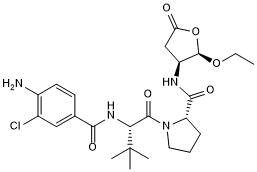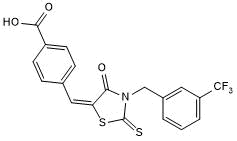Caspase Inhibitors: Small Molecules and Peptides
Caspases are a family of cytosolic aspartate-specific cysteine proteases involved in the initiation and execution of apoptosis. They are expressed as latent zymogens and are activated by an autoproteolytic mechanism or by processing by other proteases (frequently other caspases). Human caspases can be subdivided into three functional groups: cytokine activation (caspase-1, -4, -5, and -13), apoptosis initiation (caspase-2, -8, -9, -and -10), and apoptosis execution (caspase-3, -6, and -7).
Caspases are regulated by a variety of stimili, including APAF1, CFLAR/FLIP, NOL3/ARC, and members of the inhibitor of apoptosis (IAP) family such as BIRC1/NAIP, BIRC2/cIAP-1, BIRC3/cIAP-2, BIRC4/XIAP, BIRC5/Survivin, and BIRC7/Livin. IAP activity is modulated by DIABLO/SMAC or PRSS25/HTRA2/Omi. Cell-permeable and irreversible peptide inhibitors are also available for different caspases.
20 results for "Caspase Inhibitors Small Molecules and Peptides" in Products
20 results for "Caspase Inhibitors Small Molecules and Peptides" in Products
Caspase Inhibitors: Small Molecules and Peptides
Caspases are a family of cytosolic aspartate-specific cysteine proteases involved in the initiation and execution of apoptosis. They are expressed as latent zymogens and are activated by an autoproteolytic mechanism or by processing by other proteases (frequently other caspases). Human caspases can be subdivided into three functional groups: cytokine activation (caspase-1, -4, -5, and -13), apoptosis initiation (caspase-2, -8, -9, -and -10), and apoptosis execution (caspase-3, -6, and -7).
Caspases are regulated by a variety of stimili, including APAF1, CFLAR/FLIP, NOL3/ARC, and members of the inhibitor of apoptosis (IAP) family such as BIRC1/NAIP, BIRC2/cIAP-1, BIRC3/cIAP-2, BIRC4/XIAP, BIRC5/Survivin, and BIRC7/Livin. IAP activity is modulated by DIABLO/SMAC or PRSS25/HTRA2/Omi. Cell-permeable and irreversible peptide inhibitors are also available for different caspases.
Caspase-3 Inhibitor
| Purity: | ≥95% (HPLC) |
Cell-permeable, irreversible caspase inhibitor
| Chemical Name: | Benzyloxycarbonyl-Val-Ala-Asp(OMe)-fluoromethylketone |
| Purity: | ≥95% (HPLC) |
Potent pan-caspase inhibitor
| Chemical Name: | N-[2-(1,1-Dimethylethyl)phenyl]-2-oxoglycyl-N-[(1S)-1-(carboxymethyl)-2-oxo-3-(2,3,5,6-tetrafluorophenoxy)propyl]-L-alaninamide |
| Purity: | ≥98% (HPLC) |
High affinity and selective caspase-4 and caspase 1/ICE inhibitor; orally bioavailable
| Alternate Names: | Belnacasan |
| Chemical Name: | N-(4-Amino-3-chlorobenzoyl)-3-methyl-L-valyl-N-[(2R,3S)-2-ethoxytetrahydro-5-oxo-3-furanyl]-L-prolinamide |
| Purity: | ≥98% (HPLC) |
Caspase-1 and NLRP3 inflammasome inhibitor
| Chemical Name: | Ethyl 2[(2-chlorophenyl)(hydroxy)methyl]acrylate |
| Purity: | ≥98% (HPLC) |
Potent and selective inhibitor of caspases 1, 5 and 4
| Purity: | ≥95% (HPLC) |
NLRP3 inhibitor; active in vivo
| Chemical Name: | 4-[[4-Oxo-2-thioxo-3-[[3-(trifluoromethyl)phenyl]methyl]-5-thiazolidinylidene]methyl]benzoic acid |
| Purity: | ≥98% (HPLC) |








